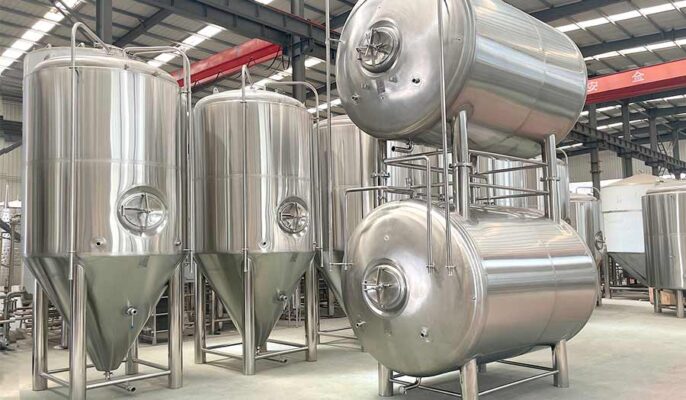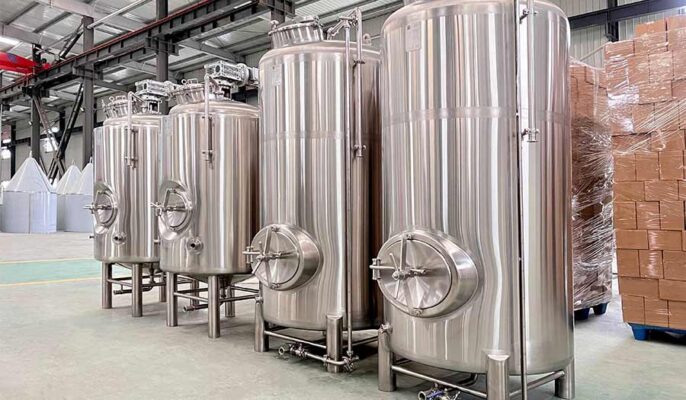스테인리스 스틸 양조 탱크는 맥주 생산 공정에서 필수적인 부분입니다. 고급 스테인리스 스틸로 제작된 이 탱크는 맥주를 발효하고 컨디셔닝하는 데 이상적인 환경을 제공합니다. 대규모 상업용 양조장이든 소규모 양조장이든 양조장의 중요한 부분입니다.
스테인리스 스틸 양조 탱크란 무엇인가요?
스테인리스 스틸 양조 탱크는 맥주 생산 공정에서 필수적인 부분입니다. 고급 스테인리스 스틸로 제작된 이 탱크는 맥주를 발효하고 컨디셔닝하는 데 이상적인 환경을 제공합니다.
스테인리스 스틸의 특징:
- 재질: 스테인리스 스틸은 부식되지 않는 특성으로 잘 알려져 있으며 액체를 장기간 보관하는 데 이상적입니다.
- 디자인: 이 탱크는 다양한 디자인으로 제공되지만 대부분 효모와 기타 침전물을 모으기 위해 바닥이 원뿔형인 원통형입니다.
- 내구성: 스테인리스 스틸 구조로 되어 있어 내구성이 뛰어나고 녹슬지 않으며 녹이 슬지 않습니다.
- 온도 제어: 많은 탱크에는 발효에 필요한 정확한 온도를 유지하기 위해 냉각 재킷이나 코일이 통합되어 있습니다.
- 위생: 스테인리스 스틸의 비다공성 표면은 박테리아 번식을 방지하여 맥주를 오염 없이 보관할 수 있습니다.
스테인리스 스틸 탱크의 종류
| 탱크 유형 | 설명 |
| 유니탱크/유니탱크 | 발효와 컨디셔닝/숙성 모두에 사용되는 단일 용기. 별도의 탱크가 필요하지 않습니다. |
| 원뿔형 발효기 | 효율적인 효모 수집 및 제거를 위해 설계된 원뿔형 바닥의 원통형 탱크입니다. |
| 원통형 발효기 | 일차 발효에 자주 사용되는 직선형 원통형 탱크입니다. |
| 밝은 맥주 탱크 | 발효 후 맥주를 컨디셔닝하고 탄산을 주입하는 데 사용됩니다. |
| 브라이트 탱크 | 완성된 맥주를 보관하고 제공하기 위한 단열 탱크. |

스테인리스 스틸 양조 탱크의 특징
- 온도 조절: 발효는 온도에 민감한 과정입니다. 스테인리스 스틸 탱크에는 맥주가 최적의 온도에서 발효될 수 있도록 냉각 재킷이나 코일이 내장되어 있는 경우가 많습니다.
- 통기 방지: 산소에 노출되면 맥주 품질이 떨어집니다. 이 탱크는 불필요한 산소 노출을 방지하기 위해 밀폐형으로 설계되었습니다.
- 효모 수집: 많은 양조 탱크의 테이퍼형 바닥은 발효 후 효모를 수집하고 제거하여 맥주를 맑게 하는 데 도움이 됩니다.
- 탄산화: 맥주에 탄산을 주입하기 위해 설계된 탱크에 이산화탄소를 주입하여 정확한 탄산 레벨을 달성할 수 있습니다.
- 맥주 보관: 양조 후 맥주는 포장하거나 소비하기 전에 통제된 환경에 보관해야 합니다. 이 탱크는 맥주가 최상의 상태를 유지하도록 보장합니다.
- 안전: 이 탱크에는 다량의 이산화탄소를 생성하는 발효 과정에서 안전을 보장하기 위해 과도한 압력을 방출하는 압력 릴리프 밸브가 장착되어 있습니다.
양조 탱크 유형의 선택은 양조 공정의 특정 요구 사항에 따라 달라집니다. 일부 양조장에서는 각 단계별로 특화된 탱크가 필요할 수 있지만, 다른 양조장에서는 다양한 용도로 사용할 수 있는 복합 탱크를 선택할 수도 있습니다.
스테인리스 스틸 양조 탱크의 장단점
다른 양조 장비와 마찬가지로 스테인리스 스틸 탱크에는 고유한 장점과 한계가 있습니다.
몇 가지 주요 장단점을 살펴보겠습니다:
| 장점 | 단점 |
| 내구성 및 수명 | 높은 초기 투자 비용 |
| 내식성 | 긁힘 또는 찌그러짐 발생 가능성 |
| 손쉬운 세척 및 살균 | 설치 및 유지 관리에 필요한 숙련된 인력 |
| 탱크 크기와 디자인의 다양성 | 제대로 패시베이션하지 않으면 맛이 변할 수 있습니다. |
| 일관된 온도 유지 | 부피가 크고 무거워 적절한 바닥 지지대가 필요함 |

나에게 맞는 스테인리스 스틸 추출 탱크를 선택하는 방법은?
올바른 스테인리스 스틸 양조 탱크를 선택하는 것은 향후 수년간 양조장 운영에 영향을 미칠 수 있는 결정입니다.
- 목적 결정: 발효기, 서비스 탱크 또는 매시 툰을 찾고 계신가요? 양조 단계에 따라 특정 유형의 탱크가 필요합니다.
- 용량 요구 사항: 크기가 중요합니다. 소규모 수제 맥주 양조장의 경우 500리터 맥주 탱크면 충분할 수 있습니다. 하지만 대규모 양조장의 경우 최대 30,000리터 이상의 용량을 갖춘 탱크가 필요할 수 있습니다.
- 공간 제한: 투자하기 전에 사용 가능한 공간을 측정하세요. 여기에는 바닥 면적뿐만 아니라 높이도 포함됩니다. 일부 탱크는 높이가 매우 높기 때문에 시설에 맞는지 확인해야 합니다.
- 예산: 가장 저렴한 옵션을 선택하고 싶을 수도 있지만, 장기적인 투자라는 점을 기억하세요. 비용과 품질의 균형을 맞추는 것이 중요합니다. 보증, 브랜드 평판 및 잠재적인 운영 비용 절감과 같은 요소를 고려하세요.
- 특징: 최신 양조 탱크에는 다양한 기능이 있습니다. 일부는 온도 제어 시스템이 통합되어 있고, 일부는 고급 효모 수집 메커니즘이나 조절 가능한 탄산 시스템을 제공하기도 합니다.
- 재질 등급: 모든 스테인리스 스틸이 똑같이 만들어지는 것은 아닙니다. 양조 탱크의 경우 내식성과 내구성 때문에 304 또는 316 스테인리스 스틸을 선택하는 것이 좋습니다.
시장에는 수많은 옵션이 있으며, 특정 요구 사항을 이해하고 각 요소를 고려하면 당연히 Micet 엔지니어의 도움을 받을 수 있습니다. 당사는 다양한 크기와 유형의 스테인리스 스틸 양조 탱크를 제공하며, 고객이 직면한 어려움을 해결하는 데 도움이 될 수 있는 맞춤형 서비스도 지원합니다.
중국에서 스테인리스 스틸 양조 탱크의 장점
| 제조사 | 스페셜티 |
| 블리히만 엔지니어링 | 고품질의 혁신적인 디자인 |
| SS 브루텍 | 모든 스케일을 위한 전문가급 탱크 |
| 브루 기어 | 내구성이 뛰어나고 효율적인 용기 |
| JV 노스웨스트 | 맞춤형 양조 솔루션 |
| 포틀랜드 케틀 웍스 | 장인 정신과 기술의 결합 |
| GW 켄트 | 포괄적인 양조 장비 제품군 |
| 빙하 탱크 | 양조 및 증류의 다양한 활용성 |
| DME 프로세스 시스템 | 글로벌 전문 지식과 맞춤형 설계 |
| 스타우트 탱크 및 주전자 | 미적 감각과 효율성 |
| 지만 홀브리카 | 풍부한 역사를 지닌 선구적인 기술 |
애플리케이션 스테인리스 스틸 양조 탱크
- 수제 맥주 양조장: 수제 맥주의 증가와 함께 중소 규모의 양조장에서는 효율성과 확장성 때문에 이 탱크를 사용하는 경우가 많습니다.
- 대규모 양조장: 이러한 작업에는 많은 양의 저장 및 발효 용량이 필요합니다. 스테인리스 스틸 탱크는 대규모 맥주 생산에 필수적인 내구성과 일관성을 제공합니다.
- 홈 브루잉: 홈 브루잉의 인기로 인해 개인용으로 설계된 소형 스테인리스 스틸 탱크가 만들어졌습니다. 이러한 제품은 홈브루어에게 전문가 수준의 양조 경험을 제공합니다.
- 비어 바와 비어 룸: 맥주 캔이 인기인 이곳에서는 맥주를 캔에서 수도꼭지까지 신선하게 서빙할 수 있습니다.
- 전문 양조: 이 탱크는 맥주 외에도 다음과 같은 용도로 사용할 수 있습니다. 콤부차 양조, 사이다 등 다양한 발효 음료에 활용할 수 있어 활용도가 높습니다.
자주 묻는 질문
Q: 스테인리스 스틸 추출 탱크는 얼마나 자주 세척해야 하나요?
A: 물탱크는 오염을 방지하고 적절한 위생 상태를 유지하기 위해 매번 사용 후 청소해야 합니다. 빈도는 양조장의 생산 일정과 청소 방식에 따라 달라질 수 있습니다.
Q: 스테인리스 스틸 추출 탱크의 수명은 얼마나 되나요?
A: 적절한 관리와 유지보수를 통해 고품질 스테인리스 스틸 탱크는 수십 년 동안 사용할 수 있으며 양조장에 가치 있는 투자입니다.
Q: MICET은 양조 탱크의 품질을 어떻게 보장하나요?
A: MICET은 최첨단 공장을 보유하고 있으며 엄격한 품질 관리 조치를 유지하고 있습니다. 각 탱크는 회사 및 국제 표준을 충족하는지 확인하기 위해 엄격한 테스트와 검사를 거칩니다.
질문: 양조 탱크를 양조장 고유의 사양에 맞게 커스터마이징할 수 있나요?
A: 예, MICET은 맞춤형 기능으로 유명합니다. 고객과 협력하여 각 양조 탱크가 크기, 디자인 또는 특수 기능 등 양조장의 특정 요구 사항에 맞게 조정되도록 합니다.




